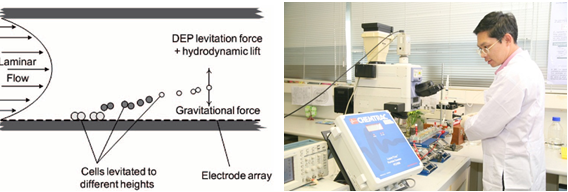Development and application of dielectrophoresis (DEP) technique for toxicity detection and circulating tumor cells isolation
A dielectrophoresis (DEP) technique has been developed and implemented for toxicity detection and circulating tumor cell isolation. DEP is a technique that merges physics and biology by subjecting cells to an electric field. When cells are exposed to chemicals, their dielectric values will differ from those of normal cells and when subjected to the same electric field may move faster than normal cells and at a rate that changes depending on the chemical concentration to which they are exposed. We have demonstrated in a mammalian cell response model the ability to detect sensitively and conveniently, via cell membrane capacitance and conductivity, toxicant activities directed toward the cell membrane, cell metabolism, and that trigger apoptosis.
Using cell dielectric differentiation, heterogeneous cell types can also be isolated. We are currently developing a DEP method for isolating cancer cells from the blood of cancer patients. Circulating tumor cells (CTCs) have been identified as negative prognostic factors in breast, prostate, colon, and other cancers, indicating that tumor cells are being released into the circulatory system from the primary tumor. Because CTCs carry the same molecular profile and surface markers as the primary tumor, they are of potentially high prognostic and diagnostic value. Immunohistochemical and/or molecular analysis of isolated CTCs can provide the same information as a surgical tissue biopsy while requiring only a small blood draw from the patient.


